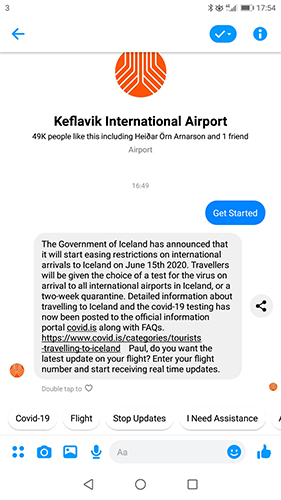An interview with Paul Brugger, CEO AirChat. By Ross Falconer
AirChat enables airports to automate their passenger communication, providing automatic responses to questions while pushing real-time flight notifications. Its multi-lingual omnichannel solution is designed to reduce workload for airports and enhance customer service.
Every passenger is different – AirChat uses data to firstly understand the passenger profile or persona, and then communicate to the passenger in the most effective and relevant manner.

As a result of COVID-19, AirChat has been able to repurpose its existing functionality. “Each airport has their own configuration; however, we are seeing airports use our timed messages to push out the latest COVID-19 information together with buttons for on-demand information on COVID and queue wait times,” explains Paul Brugger, CEO AirChat.
At its core, AirChat is data-driven, using technology such as Natural Language Processing (NLP), Artificial Intelligence (AI) and Machine Learning (ML). This means the content of the response is based on data, both flight data and passenger data, providing highly personalised, contextual responses.
The passenger has various ways to use the AirChat service, which are typically via the current airport social and chat channels. “They simply ask their question, so as an example someone might send a Facebook message to the airport’s Facebook page asking ‘Do I need to wear a mask’ or alternatively on the airport website chat window ‘Is the flight to London on time?’,” explains Paul Brugger, CEO AirChat. “Alternatively, they could like a social media icon on the flight arrivals/departures pages on the airport website.”
Brugger notes that the types of passenger questions have evolved since the COVID-19 pandemic started to impact travel. “Now that airports are starting operations again the main passenger queries are to understand the process and what to expect at the airport, and also which routes are operational.”
As a result of COVID-19, AirChat has been able to repurpose its existing functionality. “Each airport has their own configuration; however, we are seeing airports use our timed messages to push out the latest COVID-19 information together with buttons for on-demand information on COVID and queue wait times,” Brugger explains. “We’re also seeing a lot of changes to our NLP, so our technology can automatically answer passengers’ questions like ‘Do I need to wear a mask?’. Some airports are communicating different COVID messages based on the passenger’s destination, and some are using our service to speed-up the arrival process by collating passenger data prior to their arrival.”
The data-driven technology, which is typically communication based on the passenger’s persona, has also been repurposed to evenly distribute and communicate “virtual holding areas”, then filter passengers through the various airport pinch-points.
“A holding area could be an area landside, or even the person’s own car or hire car,” says Brugger. “At a predetermined time, they will be asked to proceed to security and told the shortest – least densely populated – lane. This technology would also suit the filtering of passengers to the gate, which is currently a challenge for airports.”
AirChat works closely with airports, which value its insight in terms of best practice. During the unprecedented COVID-19 pandemic, the main aim has been to put passengers at ease and help them travel safely. Brugger is proud that AirChat relieved pressure on airport customer service teams, reducing wait times and more effectively solving issues that arose during the pandemic. “It’s really nice to know we are helping them with their challenges, particularly at this difficult time. The buzz comes from passenger feedback when they are stuck, uncertain or have other concerns and they get an instant reply. I’m sure we’ve all been in that position at some stage where the lack of information compounds the issue and frustration.”







